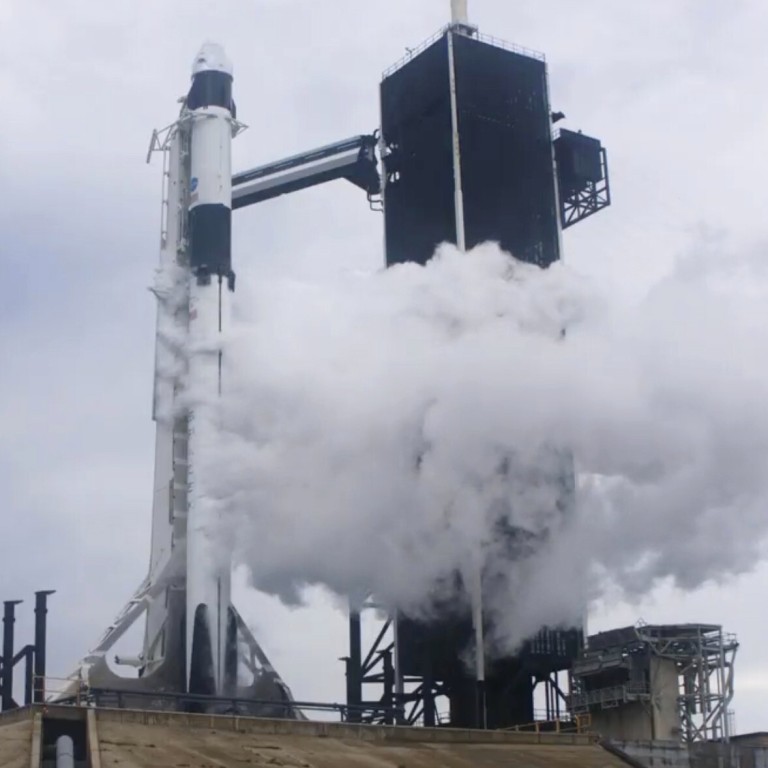
SpaceX and Nasa’s historic crewed launch aborted over bad weather
- Countdown halted less than 17 minutes before Falcon 9 rocket was expected to lift off from Kennedy Space Centre
- Mission would have marked first space flight of Nasa astronauts from US soil in almost a decade
SpaceX, billionaire entrepreneur Elon Musk’s private rocket company, was forced by foul weather to scrub a planned launch on Wednesday of two Americans into orbit from Florida, a mission that would mark the first space flight of Nasa astronauts from US soil in nine years.
The countdown was halted less than 17 minutes before the SpaceX Falcon 9 rocket was due to lift off from the Kennedy Space Centre, propelling Doug Hurley and Bob Behnken on a 19-hour ride aboard the company’s newly designed Crew Dragon capsule to the International Space Station.
The next launch window is set for Saturday afternoon, when SpaceX will make a second attempt to send the astronauts into orbit.
The scrubbed launch came on a day with off-and-on rain over Florida, and the National Weather Service had issued a tornado warning for the area. Flight operations managers were monitoring a number of ominous weather conditions, even as crews began loading the rocket with fuel.

The word finally came down that the atmosphere was so electrically charged that the spacecraft was in danger of getting hit by a bolt of lightning.
“No launch for today – safety for our crew members @Astro_Doug and @AstroBehnken is our top priority,” Nasa Administrator Jim Bridenstine tweeted, using a lightning emoji.
By then, Hurley, 53, and Behnken, 49, were already strapped into their Crew Dragon seats, after having made their way up a 80-metre (265-foot) tower to the access bridge that leads to the capsule atop the Falcon 9 rocket.
A live Nasa television broadcast live-streamed on the internet showed the two men sitting and appearing calm, side by side in their white flight suits, as the launch postponement was announced.
The right stuff: SpaceX’s first astronaut launch has cool factor
“We could see some raindrops on the windows and just figured that whatever it was, was too close to the launch pad at the time we needed it not to be,” Hurley said after the flight was cancelled. “Understand that everybody’s probably a little bit bummed out. That’s just part of the deal … We’ll do it again, I think, on Saturday.”
“Appreciate your resilience sitting there in the vehicle,” a controller replied. The astronauts had to remain strapped in their seats until all the fuel in their rocket was unloaded and the emergency escape system was disarmed.
US President Donald Trump had already flown aboard Air Force One to Florida and arrived at Cape Canaveral to observe the launch. Musk, Vice-President Mike Pence and Nasa chief Bridenstine also were there for the planned launch.
Nasa kept the guest list at Kennedy extremely limited and asked spectators to stay at home, in view of the ongoing coronavirus pandemic. Still, vehicles lined the roads around Cape Canaveral, with people staking out viewing spots. The space agency also estimated 1.7 million people were watching the launch preparations online.

Among the spectators was Erin Gatz, who came prepared for both rain and pandemic. Accompanied by her 14-year-old daughter and 12-year-old son, she brought face masks and a small tent. She said the children had faint memories of watching in person one of the last shuttle launches almost a decade ago when they were preschoolers.
“I wanted them to see the flip side and get to see the next era of space travel,” said Gatz, who lives in Deltona, Florida. “It’s exciting and hopeful.”
The astronauts were to have blasted off from the same launch pad used in 2011 by Nasa’s final space shuttle flight, which was piloted by Hurley. Since then, Nasa astronauts have had to hitch rides into orbit aboard Russia’s Soyuz spacecraft.
The flight – a long-held dream of SpaceX founder Musk – would have marked the first time a private company sent humans into orbit. It would have put the company in the same league as only three spacefaring countries – Russia, the US and China, all of which have sent astronauts into orbit.
Additional reporting by Associated Press

